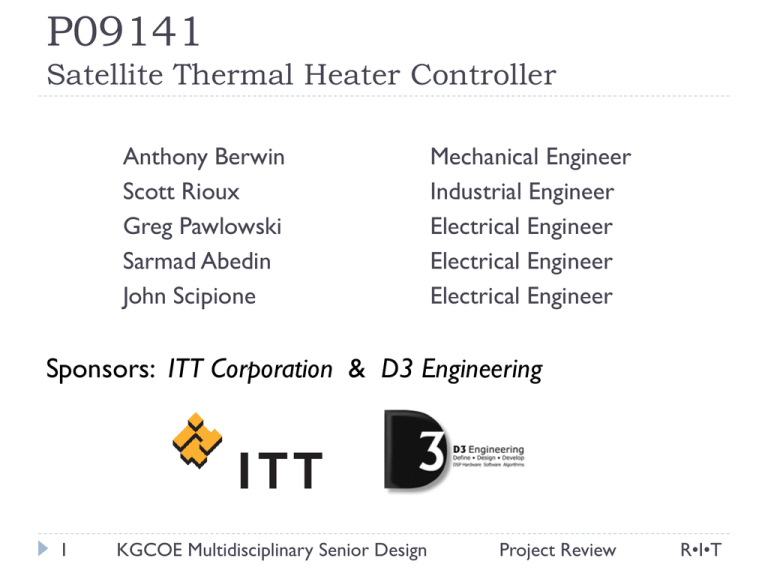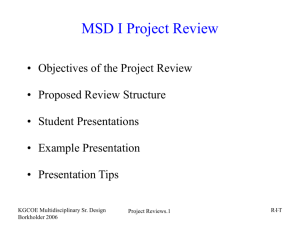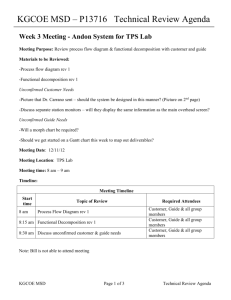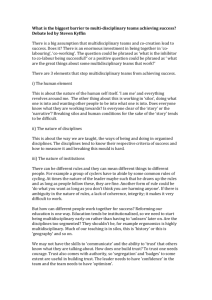Team Introduction
advertisement

P09141 Satellite Thermal Heater Controller Anthony Berwin Scott Rioux Greg Pawlowski Sarmad Abedin John Scipione Mechanical Engineer Industrial Engineer Electrical Engineer Electrical Engineer Electrical Engineer Sponsors: ITT Corporation & D3 Engineering 1 KGCOE Multidisciplinary Senior Design Project Review R•I•T Project Overview Description: Thermal Controller for Satellite Operations Market: Space Systems Division of ITT Key Deliverables: 1. 2. 3. 4. 5. 2 Power Efficiency Mass Performance Communications Cost KGCOE Multidisciplinary Senior Design Project Review R•I•T Project Concept Enclosure Interface Board Communications Programming Protocol GUI 3 KGCOE Multidisciplinary Senior Design Project Review R•I•T Project Architecture 4 KGCOE Multidisciplinary Senior Design Project Review R•I•T Milestones MSD 1 January 16, 2009 – System Level Design Review February 13, 2009 – Detailed Design Review February 20, 2009 – Project Presentation MSD II 5 March 9, 2009 – Begin Programming DSP & GUI March 13, 2009 – Materials Ordered April 3, 2009 – Testable Prototype May 1, 2009 – Testing & Debugging Completed May 20, 2009 – Final Review KGCOE Multidisciplinary Senior Design Project Review R•I•T Budget/BOM Original Budget: $1740 – $2070 Current Estimated Budget: $1703.44 All components available Shipping time 1-2 weeks Waiting on DSP’s Machine time for Enclosure 2 weeks, could outsource for faster turn around time 6 KGCOE Multidisciplinary Senior Design Project Review R•I•T Enclosure Needs & Specifications Size (Minimize) Mass (<0.3 lb) Mounting (Enclosure, PCB, Connectors*) Vibrations (23.1 G’s Random Vibration) Thermal (-40°C to +55°C) Vacuum Environment Ventilation* (<1 psi/s) Outgassing Torque on Screws* EMI Leakage* (<100 kHz) 7 KGCOE Multidisciplinary Senior Design Project Review R•I•T Enclosure Assembly Model 8 KGCOE Multidisciplinary Senior Design Project Review R•I•T Enclosure Assembly Model: Exploded View Top PCB Side A Side B Base 9 KGCOE Multidisciplinary Senior Design Project Review R•I•T Enclosure Specifications Met Total Size: 2.875” x 2.875” x 1.0625” Total Mass: 0.244 lb 18% below the 0.3 lb limit Enclosure Mounting: Size of the PCB with the Connectors: 2.61” x 2.25” x 0.5625” Flat Plate & Cylinder (R>18”) PCB Mounting: 10 Four (4) Screws & Aluminum Heat Sink Contacts KGCOE Multidisciplinary Senior Design Project Review R•I•T Enclosure Specifications Not Met Partially Met Connector Mounting Vacuum Environment Ventilation Outgassing Not Met 11 Torque on Screws EMI Leakage KGCOE Multidisciplinary Senior Design Project Review R•I•T Enclosure Risk Assessment: Risks 12 Acquiring PCB Specifications Acquiring Connector Specifications Acquiring Equipment (PCB & Connectors) Stress on the Screws Enclosure Strength KGCOE Multidisciplinary Senior Design Project Review R•I•T Enclosure Risk Assessment: Actions Acquiring PCB Specifications Acquiring Connector Specifications Failure during vibrations testing Enclosure Strength 13 Delay in the assembly of the enclosure Stress on the Screws Delay in the redesign of the enclosure or causing a redesign much later in MSD II Acquiring Equipment (PCB & Connectors) Delay in the redesign of the enclosure or causing a redesign much later in MSD II Failure during vibrations testing KGCOE Multidisciplinary Senior Design Project Review R•I•T Enclosure Risk Assessment: Mitigation Acquiring PCB Specifications Acquiring Connector Specifications Increase screw size Use temporary thread-locking adhesive Enclosure Strength 14 Work with the customer to receive the equipment Stress on the Screws Work with the customer to clarify specifications Acquiring Equipment (PCB & Connectors) Work with the customer to clarify specifications Change material to aircraft aluminum KGCOE Multidisciplinary Senior Design Project Review R•I•T Enclosure Action Items Redesign of the enclosure Increase screw size Change material to aircraft aluminum Final PCB Specifications Complete 15 Part Models Assembly Model Part Drawings Parts List BOM Enclosure Specifications Thermal and Vibrations Simulations KGCOE Multidisciplinary Senior Design Project Review R•I•T Interface Board Overview Purpose Master and slave communications over a power bus Isolation from 28VDC Power Bus Transmit/Receive Switching Transmit/Receive Signal Conditioning Voltage conversion 16 KGCOE Multidisciplinary Senior Design Project Review R•I•T Interface Board Block Diagram 17 KGCOE Multidisciplinary Senior Design Project Review R•I•T Interface Board DC Isolation Need There are no dedicated communication lines RF signals will interfere with other satellite operations Power bus already available Isolation of communications signal from DC power bus to protect electronics 18 KGCOE Multidisciplinary Senior Design Project Review R•I•T Interface Board Switching Need Transmitting the communications signal Receiving the communications signal It is necessary to switch between the two modes of operation 19 KGCOE Multidisciplinary Senior Design Project Review R•I•T Interface Board Voltage Converter Need 20 Negative supply voltage to operate electronics on interface board Will take a input voltage and output the same negative voltage KGCOE Multidisciplinary Senior Design Project Review R•I•T Interface Board Receive Signal Conditioning Need 21 Filter out noise from communications signal Amplify communications signal for ADC Offset communications signal to positive voltage for ADC KGCOE Multidisciplinary Senior Design Project Review R•I•T Interface Board Transmit Signal Conditioning Need 22 Filter out high frequency harmonics from communications signal Generate the communications signal from pulse width modulator KGCOE Multidisciplinary Senior Design Project Review R•I•T Interface Board Risk Assessment: Risks Low frequency noise not filtered out Transient noise not accounted for Power consumption of IC’s Design of filters 23 KGCOE Multidisciplinary Senior Design Project Review R•I•T Interface Board Risk Assessment: Actions Low frequency noise not filtered out Transient noise not accounted for Communication errors, or signal not received Power consumption of IC’s Communication errors, or signal not received Use to much power, other systems will not work Design of filters 24 Filters do not function properly KGCOE Multidisciplinary Senior Design Project Review R•I•T Interface Board Risk Assessment: Mitigation Low frequency noise not filtered out Transient noise not accounted for Power consumption of IC’s Write better demodulation algorithm, use more hardware demodulation techniques Switch to low power modes when not in use Design of filters 25 Do more research on filter design, or seek help in filter design from experienced engineers KGCOE Multidisciplinary Senior Design Project Review R•I•T Interface Board Action Items Finalize parts for interface board Build prototype and test 26 KGCOE Multidisciplinary Senior Design Project Review R•I•T Programming Architecture 27 KGCOE Multidisciplinary Senior Design Project Review R•I•T Programming Needs PC communicate with Master DSP over serial line. Master DSP communicate with each slave over 28V heater power bus. No dedicated lines are available. Modulation and demodulation is needed. 28 KGCOE Multidisciplinary Senior Design Project Review R•I•T Programming DSP The bits of the protocol must be generated, stored, and interpreted. A sine wave must be generated from binary using PWM/ DAC. Signal demodulated back into binary using ADC. Communication with the PC GUI over SCI. 29 KGCOE Multidisciplinary Senior Design Project Review R•I•T Programming How are we going to do it? Code Composer will be used to Program the DSP in the C programming language. The ADC, PWM, UART, and SCI modules are all utilized. The program is stored in flash memory. The protocol bits are stored in RAM memory. 30 KGCOE Multidisciplinary Senior Design Project Review R•I•T Programming Risks Acquiring the DSP. Programming will be difficult to begin without the DSP. Learning the Code Composer Environment. Code Composer comes with the DSP. Programming each of the DSP elements that need to be programmed including PWM, ADC, the protocol, serial communication. Finding code examples. Writing and testing the code. 31 KGCOE Multidisciplinary Senior Design Project Review R•I•T Protocol Communications SCI protocol (LabView to Master) 32 3 Pins - Transmit, Receive, Ground 4 Transmissions - 12 Bit Each 1 Start Bit 8 Data Bits(Slave ID, Temp. Bits, Ctrl Bits, etc) 1 Parity Bit (Eliminates Checksum) 2 End Bits KGCOE Multidisciplinary Senior Design Project Review R•I•T Protocol Communications UART Protocol (Master to Slave) 33 Bi-directional, half-duplex (only slave or master can talk at one time) Bit by bit transmission Different frequencies for ‘1’ and ‘0’ (in order to meet the 20 ms spec, min. freq = 5kHz; 200 us/bit) ‘0’ frequency = 7.5 kHz ‘1’ frequency = 17.5 kHz No activity on line = noise only KGCOE Multidisciplinary Senior Design Project Review R•I•T Protocol Communications 40 Bit Transmission 34 2 Start Bits 6 Checksum Bits 12 Data (temp) Bits 6 Control Bits (read/set, temp/htr state, etc.) 5 Telemetry Pins 8 Bits for Slave ID 1 End Bit KGCOE Multidisciplinary Senior Design Project Review R•I•T Protocol Risk Assessment: Risks 35 Transfer rate too slow Not enough bits to account for other details Bit/error rate too high KGCOE Multidisciplinary Senior Design Project Review R•I•T Protocol Risk Assessment: Actions Transfer rate too slow Not enough bits to account for other details Not all data will be represented and can lead to a lack of outputting required data Bit/error rate too high 36 Timing issues between the receiver and transmitter leading to wrong messages being transferred The wrong message to be transmitted and the appropriate output will not be achieved KGCOE Multidisciplinary Senior Design Project Review R•I•T Protocol Risk Assessment: Mitigation Transfer rate too slow Not enough bits to account for other details Bits will be added to protocol and the appropriate transfer rates will be calculated. Bit/error rate too high 37 Can decrease the time it takes to send a bit Reduction in signal to noise ratio must be changed or an increase in the bandwidth. KGCOE Multidisciplinary Senior Design Project Review R•I•T Protocol Action Items Acquiring EzDSP Program the DSP using the FSM flowchart in order to communicate from GUI to Master and Master to Slave Work with the interface and PWM and ADC programming to ensure proper communication 38 KGCOE Multidisciplinary Senior Design Project Review R•I•T Graphical User Interface Overview System required a simple computer interface Needed to be able to control DSP’s and send commands Easily readable and intuitive Be able to control multiple parameters Be able to communicate via Serial Port Able to control 256 DSP’s 39 KGCOE Multidisciplinary Senior Design Project Review R•I•T Graphical User Interface Risk Assessment: Risks 40 Time Constraints Connectivity Problems Testing, Replication Table Loopback Testing Programming Constraints Final Implementation Requires Working DSP Programming KGCOE Multidisciplinary Senior Design Project Review R•I•T Graphical User Interface Risk Assessment: Actions Time Constraints Connectivity Problems Trouble Programming in LabView Final Implementation Requires Working DSP Programming 41 Cannot Initiate Link over Serial Programming Constraints Testing will be more difficult Loopback Testing Will not complete GUI to Master Link Testing, Replication Table GUI will not get completed Final Product will not be completed in time KGCOE Multidisciplinary Senior Design Project Review R•I•T Graphical User Interface Risk Assessment: Mitigation Distribution of tasks Research and Examples Faculty Help Purchasing own DSP board Discussion about final deliverables, removing requirements 42 KGCOE Multidisciplinary Senior Design Project Review R•I•T Graphical User Interface Concept Selection There were 5 candidates for GUI creation GUI have 5 parameters in which we rated it on Visual Basic LabView MATLAB Java C++ Ease of Use Safety Programmability Customer Preference Familiarity A concept selection and screening methods were both used to help determine which method would be best 43 KGCOE Multidisciplinary Senior Design Project Review R•I•T Graphical User Interface Concept Selection GUI A B Conce pts C VB Labvie w C++ D E Java M atLab Weigh Rating Weight Rating Weight Rating Weight Rating Weight Rating Weight Se le ction Crite ria ed Score t ed Score ed Score ed Score ed Score Ease of Programmability 25% 3 0.75 3 0.75 2 0.5 2 0.5 3 0.75 Safety 25% 3 0.75 3 0.75 1 0.25 3 0.75 3 0.75 Familiarity 25% 3 0.75 4 1 1 0.25 1 0.25 3 0.75 Cust Preference 15% 3 0.45 2 0.3 2 0.3 2 0.3 3 0.45 Ease of Use 10% 2 0.2 4 0.4 3 0.3 3 0.3 1 0.1 Total Score 2.90 0 0 0 0 0 0 0 0 0 0 0 0 0 0 0 0 0 0 0 0 0 0 0 0 0 3.20 1.60 2.10 2.80 Rank Continue? 44 no winner KGCOE Multidisciplinary Senior Design no no Project Review no R•I•T Graphical User Interface LabView LabView was chosen mainly because of its ease of use, and familiarity between the team members LabView allows us to easily create a nice GUI with multiple features LabView is also scalable, allows us to add or change features easily without rewriting all of the programming 45 KGCOE Multidisciplinary Senior Design Project Review R•I•T Graphical User Interface Required Features LabView needs to have visual indicators Communicate over serial port (RS232) Ability to see system status Ability to set and change set points Ability to chose between 255 slaves to upload temperature 46 KGCOE Multidisciplinary Senior Design Project Review R•I•T Graphical User Interface Front Panel 47 KGCOE Multidisciplinary Senior Design Project Review R•I•T Graphical User Interface Communication LabView will communicate with the Master via RS232 ASCII Four 12bit transmissions to communicate all data 48 KGCOE Multidisciplinary Senior Design Project Review R•I•T Graphical User Interface Action Items Complete Replication Table Replication Table Parameters Complete Communication Development from GUI to Master Start Loop-Back Testing 49 KGCOE Multidisciplinary Senior Design Project Review R•I•T






